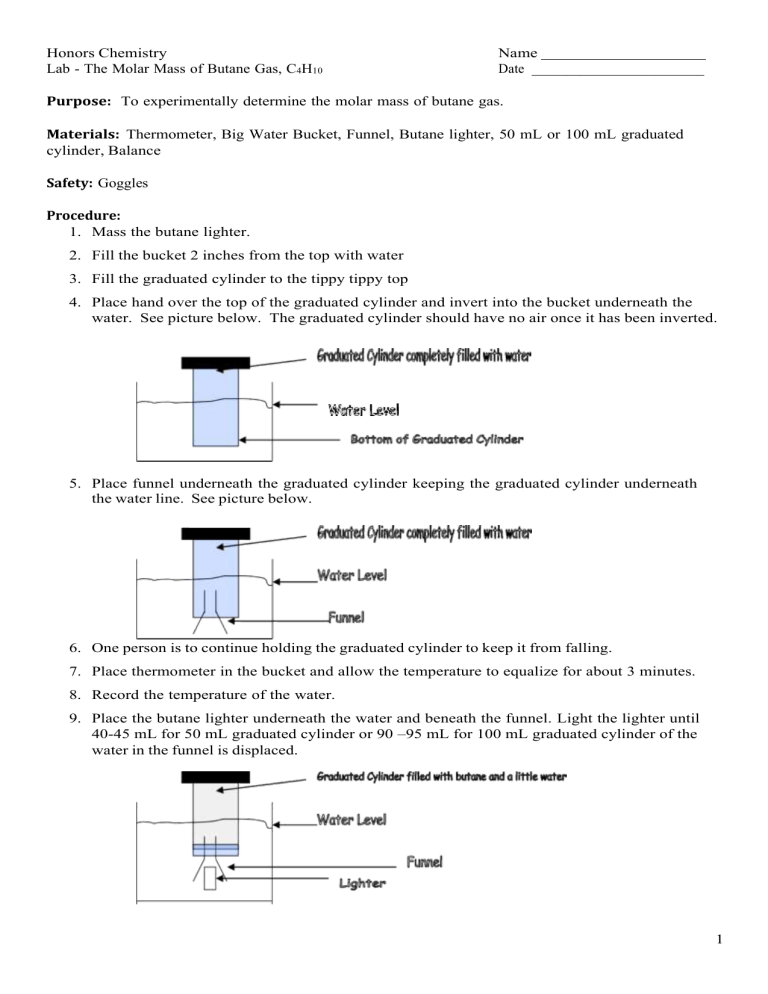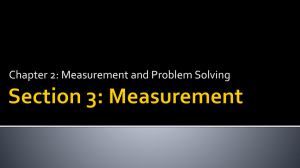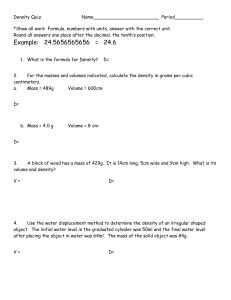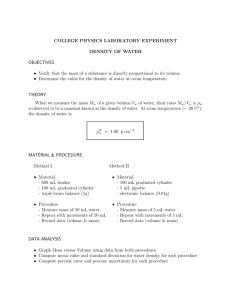
Honors Chemistry Lab - The Molar Mass of Butane Gas, C4H10 Name Date _________________________ Purpose: To experimentally determine the molar mass of butane gas. Materials: Thermometer, Big Water Bucket, Funnel, Butane lighter, 50 mL or 100 mL graduated cylinder, Balance Safety: Goggles Procedure: 1. Mass the butane lighter. 2. Fill the bucket 2 inches from the top with water 3. Fill the graduated cylinder to the tippy tippy top 4. Place hand over the top of the graduated cylinder and invert into the bucket underneath the water. See picture below. The graduated cylinder should have no air once it has been inverted. 5. Place funnel underneath the graduated cylinder keeping the graduated cylinder underneath the water line. See picture below. 6. One person is to continue holding the graduated cylinder to keep it from falling. 7. Place thermometer in the bucket and allow the temperature to equalize for about 3 minutes. 8. Record the temperature of the water. 9. Place the butane lighter underneath the water and beneath the funnel. Light the lighter until 40-45 mL for 50 mL graduated cylinder or 90 –95 mL for 100 mL graduated cylinder of the water in the funnel is displaced. 1 10. Lift the graduated cylinder until the level of butane is level with the water level in the bucket. See picture. 11. Record the volume of butane in the graduated cylinder. 12. The instructor will provide the atmospheric pressure from the weather channel. 13. Determine the partial pressure of water using the temperature of the water and the chart for vapor pressure of water. 14. Shake out the butane lighter. Do NOT depress the plunger on the lighter or your results will be VERY flawed. Ensure that the lighter is completely dry before massing. 15. Pour the water down the drain and return all materials to proper locations. Data Table: Initial Mass of the Butane Lighter 21.77 grams Temperature of the Water 21.0oC Volume of Butane in the graduated cylinder 164 mL Atmospheric Pressure 29.76 in Hg Final Mass of the Butane Lighter 21.44 grams Calculations 1. Determine the mass of butane in the graduated cylinder. Subtract the initial mass minus the final mass: 21.77 𝑔𝑟𝑎𝑚𝑠 − 21.44 𝑔𝑟𝑎𝑚𝑠 = 0.33 𝑔𝑟𝑎𝑚𝑠 2. Determine the atmospheric pressure in mm Hg. Convert in Hg to mm Hg 1000 𝑚𝑚 𝐻𝑔 29.76 𝑖𝑛 𝐻𝑔 2.54 𝑐𝑚 𝐻𝑔 1 𝑚 𝐻𝑔 𝑥 = 755. 𝟗04 𝑚𝑚 𝐻𝑔 𝑥 𝑥 1 1 𝑖𝑛 𝐻𝑔 100 𝑐𝑚 𝐻𝑔 1 𝑚 𝐻𝑔 Bolded number is the last significant figure – 4 significant figures 2 3. Determine the vapor pressure of water using the chart provided. 2.49 kPa – convert to mmHg 2.49 𝑘𝑃𝑎 1 𝑥 760 𝑚𝑚𝐻𝑔 = 18. 𝟔81145 𝑚𝑚𝐻𝑔 101.3 𝑘𝑃𝑎 Bolded number is the last significant figure – 4 significant figures 4. Determine the pressure of the dry butane in the graduated cylinder. Which gas law should you use? Use Dalton’s Law of Partial Pressures 𝑃𝑇𝑜𝑡𝑎𝑙 = 𝑃𝐵𝑢𝑡𝑎𝑛𝑒 + 𝑃w𝑎𝑡𝑒𝑟 𝑣𝑎𝑝𝑜𝑟 𝑃𝑡𝑜𝑡𝑎𝑙 = 755.904 𝑚𝑚 𝐻𝑔 𝑃w𝑎𝑡𝑒𝑟 𝑣𝑎𝑝𝑜𝑟 = 18.681145 𝑚𝑚 𝐻𝑔 𝑃𝑏𝑢𝑡𝑎𝑛𝑒 = 𝑃𝑡𝑜𝑡𝑎𝑙 − 𝑃w𝑎𝑡𝑒𝑟 𝑣𝑎𝑝𝑜𝑟 = 755.904 𝑚𝑚𝐻𝑔 − 18.681145 𝑚𝑚𝐻𝑔 = 737. 𝟐228 𝑚𝑚𝐻𝑔 Bolded number is the last significant figure – 4 significant figures 5. Determine the volume of the butane in the graduated cylinder. 164 mL – convert to Liters 164 𝑚𝐿 1𝐿 = 0.164 𝐿 𝑥 1 1000 𝑚𝐿 Three significant figures 6. Determine the moles of butane using which gas law? Ideal Gas Law – PV = nRt P = 737.2228 mmHg (4 significant figures) V = 0.164 L (three significant figures) R = 62.4 L*mmHg/ mole*K (infinite signficicant figures) T = 21.0oC = 294.0K (4 signiciant figures) 𝑛= 𝑃𝑉 = 737.2228 𝑚𝑚𝐻𝑔 (0.164 𝐿) = 0.0065𝟗0383 𝑚𝑜𝑙𝑒𝑠 𝐿 ∗ 𝑚𝑚𝐻𝑔 𝑅𝑇 62.4 (294.0 𝐾) 𝑚𝑜𝑙𝑒 ∗ 𝐾 Bolded number is the last significant figure – 3 significant figures 7. Determine the molar mass, M = m/n. M = 0.33 grams (2 significant figures) N – 0.006590383 moles (3 significant figures) 𝑔 𝑚 0.33 = 50.0729 = 50. 𝑔𝑟𝑎𝑚𝑠/𝑚𝑜𝑙𝑒 𝑜𝑟 5.0 𝑥 101 𝑔𝑟𝑎𝑚𝑠/𝑚𝑜𝑙𝑒 𝑀= = 𝑔𝑟𝑎𝑚𝑠 𝑛 0.006590383 𝑚𝑜𝑙𝑒𝑠 𝑚𝑜𝑙𝑒 8. Determine the percent error. Molar Mass of Butane C4H10 = 58.123 g/mole 𝑔 𝑔 58.123 − 50. 𝑎𝑐𝑐𝑒𝑝𝑡𝑒𝑑 − 𝑒𝑥𝑝𝑒𝑟𝑖𝑚𝑒𝑛𝑡𝑎𝑙 𝑚𝑜𝑙𝑒 𝑚𝑜𝑙𝑒 𝑚𝑜𝑙𝑒 𝑃𝑒𝑟𝑐𝑒𝑛𝑡 𝐸𝑟𝑟𝑜𝑟 = 𝑥 100 = 𝑔 𝑎𝑐𝑐𝑒𝑝𝑡𝑒𝑑 58.123 3 𝑥 100 = 13.98% 4 5





